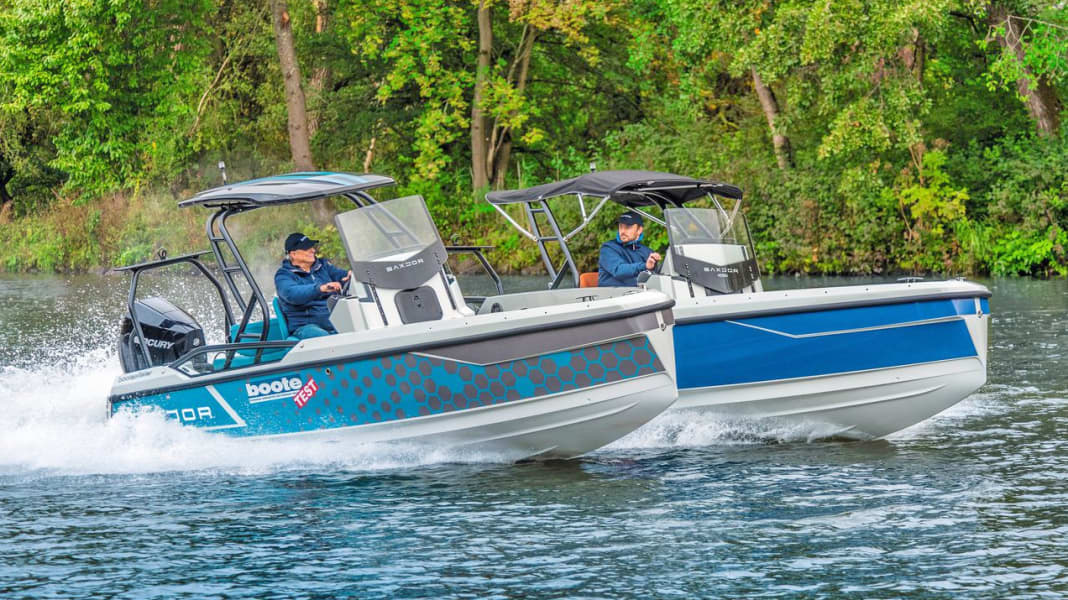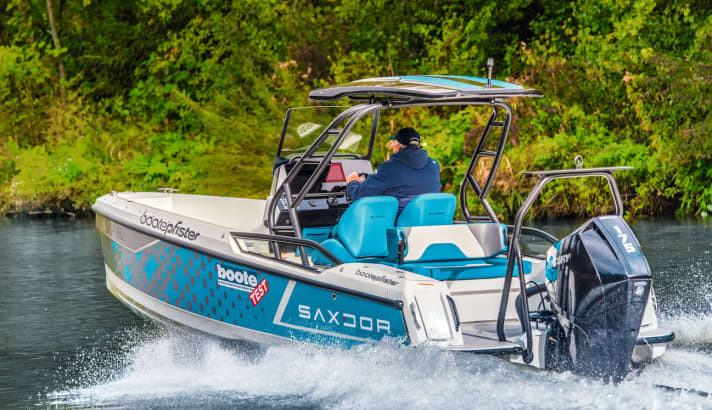
They are both stylish. Without question. With its straight stem, open transom and stylish roll bar for the T-top (or bimini), the Saxdor sits somewhere between the Axopar, the Nimbus T-series and the XO. An undoubtedly Scandinavian boat that cannot be said to be timeless. Rather, it fits in perfectly with the times. A boat for everyone, whether beginner or professional.
The Saxdor 200 Sport model for beginners is available at a slightly lower price: With the 100 hp engine from Mercury (alternatively: 115 hp) and ready-to-drive, functional equipment from 26560 euros. The Saxdor 200 Pro Sport variant, designed for the more experienced skipper, not only has a sophisticated, more elegant interior with a sports steering wheel, trim tabs and a soft anti-slip surface on the foredeck, but also has sportier engines between 150 and 175 hp in its repertoire. It is available from 37128 euros. We want to test the two sisters, one with the smallest engine, the other with the largest.
Need more information? You can find the engine comparison test of the Saxdor 200 Sport / Pro Sport with technical data and further images in BOOTE issue 01/2020 at newsagents or online at Delius Klasing Shop.
Regardless of the version, the Saxdor makes a good impression from the jetty and almost looks like a shrunken megayacht tender. In addition, both test boats have two rows of four seats (plus 2390 euros) as an alternative to the standard jockey bench seat (three seats). Furthermore, a water
ski towing mast (870 euros) and a "roll bar" with bimini (on the 200 Sport 1914 euros) or with targa roof (on the 200 Pro Sport 2146 euros).
The helm station on both models is very tidy, the surface consists of two black acrylic glass panels. A 9-inch Simrad plotter is flush-mounted in the centre of the upper panel and is the only instrument on the 200 Sport that provides information about the engine and speed. On the port side of the "dashboard" is a switch panel with eight backlit pushbuttons. The labelling is engraved in white into the Plexiglas surface from behind and is also backlit in white when activated, which makes a very high-quality and elegant impression.

As a special highlight, the windscreens run on sliding rails and can be adjusted in height using two knurled screws. When the windscreen is pushed all the way up, a waterproof storage box cover appears behind it, concealing the very neatly finished electrical installation. The circuit breakers are also embedded in a transparent disc. Chic down to the last detail. The only negative aspect is that the grab handle above the helm is very close to the sharp-edged acrylic glass panel. The throttle lever (mechanical) of the 200 Sport is also too close to the control panel, and it is awkward to operate the trim at full throttle. This is better realised on the 200 Pro Sport - thanks to the more compact electric control.
The storage compartments are generously dimensioned. In addition to the two self-draining lockers on either side of the engine, there are also two large stowage compartments under the benches. A large, watertight floor hatch directly in front of the engine provides access to the rear bilge with the battery and other installations. However, the most space is provided by the storage space under the sundeck in the bow, above which the entire sunbathing area (1.95 x 1.26 m) can be raised using gas struts. The tarpaulin, wakeboard and sunbathing cushions disappear effortlessly here. Both boats also have the camper top (1137 euros) on board as an optional extra. A concept that you won't find on any other boat, as this tent allows the storage space to be quickly transformed into a sleeping cabin. Whether for a midday nap or even a weekend on the boat - camping on the water.

The open stern of the Saxdor gives the boat a sporty look and makes it very comfortable for wakeboarders to put on their equipment and jump off - but it doesn't exactly look suitable for families. A folding railing as an extra would be desirable. There are two ventilation openings above the transom, which draw petrol vapours out of the bilge thanks to the negative pressure created by the airstream. However, the driving test shows that this realisation also has a catch: If the boat is stopped too quickly, it is easy for the stern wave to roll into the open cockpit and get into the ventilation openings and from there into the bilge. If the bilge fills up, the extraction opening for the petrol vapours is under water and no longer has any function.
We take both boats for a test drive. The Saxdor with the 100 hp engine is easy to manoeuvre in the harbour and is a pleasure to drive in reverse with its extremely tight turning circles. As expected, fast reversing should be avoided with the open stern. From around 1300 rpm and three knots, water can run into the cockpit. Stopping quickly must also be done carefully - otherwise you should at least remember to pull your feet up in good time before the stern wave reaches the steering position.
The boat runs well on course at slow and fast displacement speeds. It is only slightly affected by extreme weight shifts. At 3500 rpm, the Saxdor switches to planing speed without lifting the bow much and runs well and economically at 4000 rpm with 21 knots. The 200 Sport reaches its top speed of 31.9 knots with a little trim at 5500 rpm.

The boat leans heavily on its side when sailing in tight circles with the trim down, and you inevitably worry that water will run into the cockpit at the side. But this is completely unfounded, everything stays dry. In cruising trim, on the other hand, the propeller quickly draws air and the boat loses speed. With moderate trim and speed, however, even the tight circles are successful. The boat behaves similarly in tight turns and slaloms. Although the Saxdor with its 100 hp engine (74 kW) is still approved for use on Lake Constance, there are times when you wish it had a few more hp. This is particularly noticeable when jumping over the stern wave of the photo boat. Due to a lack of speed, it lingers a little longer on the crest of the wave before tilting steeply forwards and smashing into the wave trough with the nose of the bow. Completely harmless - just wet.
The Saxdor 200 Pro Sport with 175 hp, on the other hand, jumps elegantly and powerfully over wave crests and troughs and comes to land behind them in smooth water. The rest of the handling behaviour is similar to that of her sister: circling, turning and tearing is quite passable with trim down to 30 knots, in cruising trim the propeller quickly draws air. The further the drive is down, the more accurately the boat stays on track. The slalom up to around 38 knots works wonderfully. At higher speeds, however, it is noticeable that slight steering movements cause the boat to roll even at the stern. At full speed and 43.7 knots, the driver should therefore be careful and not make any overly hectic manoeuvres.
Conclusion: The Saxdor 200 Sport is an extremely successful boat that is just as much fun for beginners with a slightly smaller engine as it is for experienced boaters looking for a handy, uncomplicated trailer boat with plenty of power and good performance. The developers have paid great attention to detail, and even the entry-level version of the 200 Sport offers the equipment and finish you would expect from many higher-priced boats. With the optional tent, it is even possible to spend a weekend on board in an ingenious way. The price-performance ratio is excellent.

